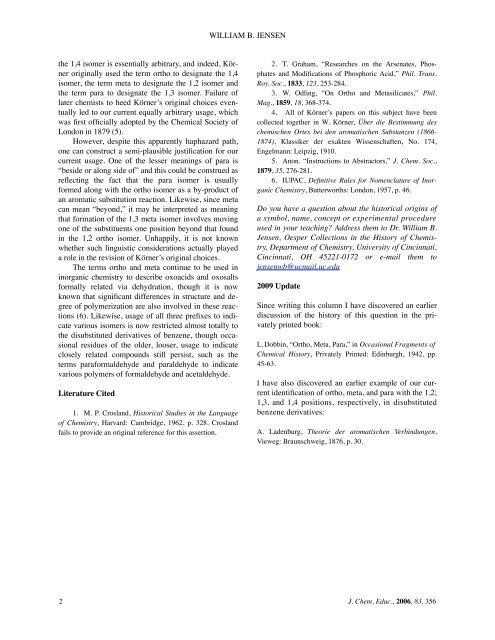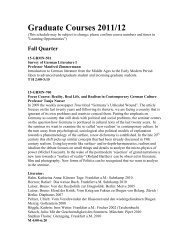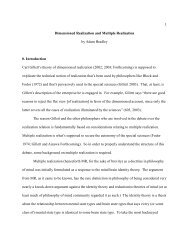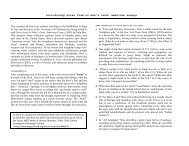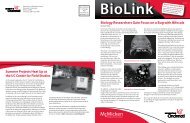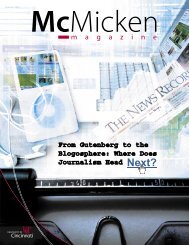126. Othro, Meta, Para.pdf - University of Cincinnati
126. Othro, Meta, Para.pdf - University of Cincinnati
126. Othro, Meta, Para.pdf - University of Cincinnati
You also want an ePaper? Increase the reach of your titles
YUMPU automatically turns print PDFs into web optimized ePapers that Google loves.
the 1,4 isomer is essentially arbitrary, and indeed, Körner<br />
originally used the term ortho to designate the 1,4<br />
isomer, the term meta to designate the 1,2 isomer and<br />
the term para to designate the 1,3 isomer. Failure <strong>of</strong><br />
later chemists to heed Körner’s original choices eventually<br />
led to our current equally arbitrary usage, which<br />
was first <strong>of</strong>ficially adopted by the Chemical Society <strong>of</strong><br />
London in 1879 (5).<br />
However, despite this apparently haphazard path,<br />
one can construct a semi-plausible justification for our<br />
current usage. One <strong>of</strong> the lesser meanings <strong>of</strong> para is<br />
“beside or along side <strong>of</strong>” and this could be construed as<br />
reflecting the fact that the para isomer is usually<br />
formed along with the ortho isomer as a by-product <strong>of</strong><br />
an aromatic substitution reaction. Likewise, since meta<br />
can mean “beyond,” it may be interpreted as meaning<br />
that formation <strong>of</strong> the 1,3 meta isomer involves moving<br />
one <strong>of</strong> the substituents one position beyond that found<br />
in the 1,2 ortho isomer. Unhappily, it is not known<br />
whether such linguistic considerations actually played<br />
a role in the revision <strong>of</strong> Körner’s original choices.<br />
The terms ortho and meta continue to be used in<br />
inorganic chemistry to describe oxoacids and oxosalts<br />
formally related via dehydration, though it is now<br />
known that significant differences in structure and degree<br />
<strong>of</strong> polymerization are also involved in these reactions<br />
(6). Likewise, usage <strong>of</strong> all three prefixes to indicate<br />
various isomers is now restricted almost totally to<br />
the disubstituted derivatives <strong>of</strong> benzene, though occasional<br />
residues <strong>of</strong> the older, looser, usage to indicate<br />
closely related compounds still persist, such as the<br />
terms paraformaldehyde and paraldehyde to indicate<br />
various polymers <strong>of</strong> formaldehyde and acetaldehyde.<br />
Literature Cited<br />
1. M. P. Crosland, Historical Studies in the Language<br />
<strong>of</strong> Chemistry, Harvard: Cambridge, 1962, p. 328. Crosland<br />
fails to provide an original reference for this assertion.<br />
WILLIAM B. JENSEN<br />
2. T. Graham, “Researches on the Arsenates, Phosphates<br />
and Modifications <strong>of</strong> Phosphoric Acid,” Phil. Trans.<br />
Roy. Soc., 1833, 123, 253-284.<br />
3. W. Odling, “On Ortho and <strong>Meta</strong>silicates,” Phil.<br />
Mag., 1859, 18, 368-374.<br />
4. All <strong>of</strong> Körner’s papers on this subject have been<br />
collected together in W. Körner, Über die Bestimmung des<br />
chemischen Ortes bei den aromatischen Substanzen (1866-<br />
1874), Klassiker der exakten Wissenschaften, No. 174,<br />
Engelmann: Leipzig, 1910.<br />
5. Anon. “Instructions to Abstractors,” J. Chem. Soc.,<br />
1879, 35, 276-281.<br />
6. IUPAC, Definitive Rules for Nomenclature <strong>of</strong> Inorganic<br />
Chemistry, Butterworths: London, 1957, p. 46.<br />
Do you have a question about the historical origins <strong>of</strong><br />
a symbol, name, concept or experimental procedure<br />
used in your teaching? Address them to Dr. William B.<br />
Jensen, Oesper Collections in the History <strong>of</strong> Chemistry,<br />
Department <strong>of</strong> Chemistry, <strong>University</strong> <strong>of</strong> <strong>Cincinnati</strong>,<br />
<strong>Cincinnati</strong>, OH 45221-0172 or e-mail them to<br />
jensenwb@ucmail.uc.edu<br />
2009 Update<br />
Since writing this column I have discovered an earlier<br />
discussion <strong>of</strong> the history <strong>of</strong> this question in the privately<br />
printed book:<br />
L. Dobbin, “Ortho, <strong>Meta</strong>, <strong>Para</strong>,” in Occasional Fragments <strong>of</strong><br />
Chemical History, Privately Printed: Edinburgh, 1942, pp.<br />
45-63.<br />
I have also discovered an earlier example <strong>of</strong> our current<br />
identification <strong>of</strong> ortho, meta, and para with the 1,2;<br />
1,3, and 1,4 positions, respectively, in disubstituted<br />
benzene derivatives:<br />
A. Ladenburg, Theorie der aromatischen Verbindungen,<br />
Vieweg: Braunschweig, 1876, p. 30.<br />
2 J. Chem. Educ., 2006, 83, 356


